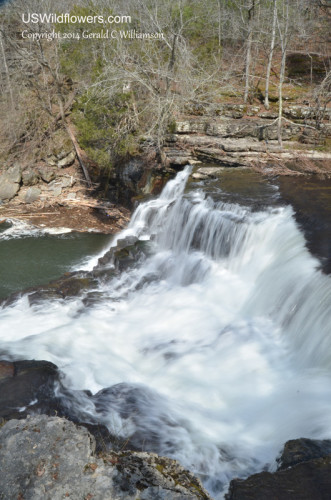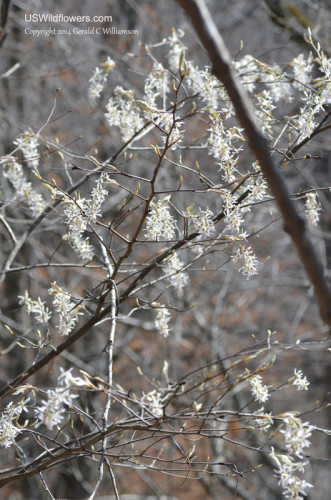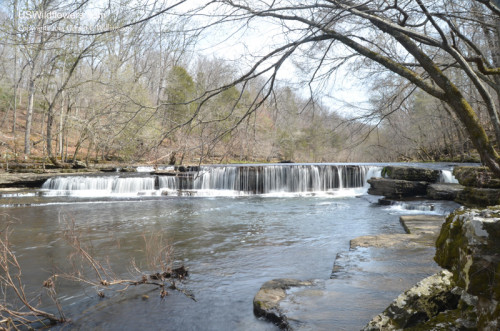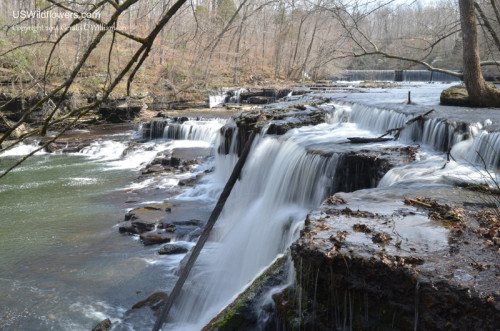On April 2, the next day after our Walls of Jericho hike, Dave Ridge and I went by Tennessee’s Old Stone Fort State Archaeological Park in Manchester. After the strenuous hike of the day before, we wanted something that was easy. Both of us were impressed by this park, and we only explored a relatively small portion of the available hiking trails. In addition to some trails in other parts of the park, you have several options to explore the section which includes the 2,000-year old earth-covered stone walls – you can stay fairly level up along the top, or take alternate routes down to the river. As we walked along the trail, we heard falling water – the drop off the edge of Tennessee’s highland rim into the central basin forms several very nice waterfalls on both the Big Duck and Little Duck Rivers, just before they converge within the park to form the Duck River.

Big Falls on Big Duck River, Old Stone Fort State Archeological Park. This was the site of a large mill in the 19th century.
Due to time constraints, this was just a survey trip for the park. I knew there would be wildflowers since I had read that Jack Carman, author of Wildflowers of Tennessee, had led a wildflower hike the week before around the park. While not as abundant or varied as on the 6-mile Walls of Jericho hike, we were not disappointed, and we only covered about 1.25 miles of the nearly 6 miles of trails in the park. Among the plants in bloom that we saw were Serviceberry, Toadshade Trillium, Bluets, Rue Anemone, Hepatica, and Early Saxifrage.
 Amelanchier species." width="331" height="500" srcset="https://journal.uswildflowers.com/wp-content/uploads/2014/04/DSC_8471_OSFC-331x500.jpg 331w, https://journal.uswildflowers.com/wp-content/uploads/2014/04/DSC_8471_OSFC-99x150.jpg 99w, https://journal.uswildflowers.com/wp-content/uploads/2014/04/DSC_8471_OSFC.jpg 530w" sizes="(max-width: 331px) 100vw, 331px" /> Serviceberry – Amelanchier species. This is a small tree or occasionally a shrub.
Amelanchier species." width="331" height="500" srcset="https://journal.uswildflowers.com/wp-content/uploads/2014/04/DSC_8471_OSFC-331x500.jpg 331w, https://journal.uswildflowers.com/wp-content/uploads/2014/04/DSC_8471_OSFC-99x150.jpg 99w, https://journal.uswildflowers.com/wp-content/uploads/2014/04/DSC_8471_OSFC.jpg 530w" sizes="(max-width: 331px) 100vw, 331px" /> Serviceberry – Amelanchier species. This is a small tree or occasionally a shrub.Unfortunately I made neither notes nor photographic record of all the wildflowers we saw, so I’m sure I missed mentioning some, and I didn’t photograph the waterfalls over on the Little Duck River, but here are couple more photos of waterfalls on the Big Duck River.
This is one of Tennessee’s State Parks that I will return to for a more leisurely visit, perhaps for an all-day day-trip, or for a night or two in the campground. While the one lane bridge across the mill dam lake is a bit tight, as are the 10-foot wide paved parking pads at the campsites, I think I could squeeze my 36.5′ motorhome into one of the attractive sites overlooking the lake. It should be noted that several of the sites on the lake side of the main road were marshy, and partially inundated with water the day we drove through.



